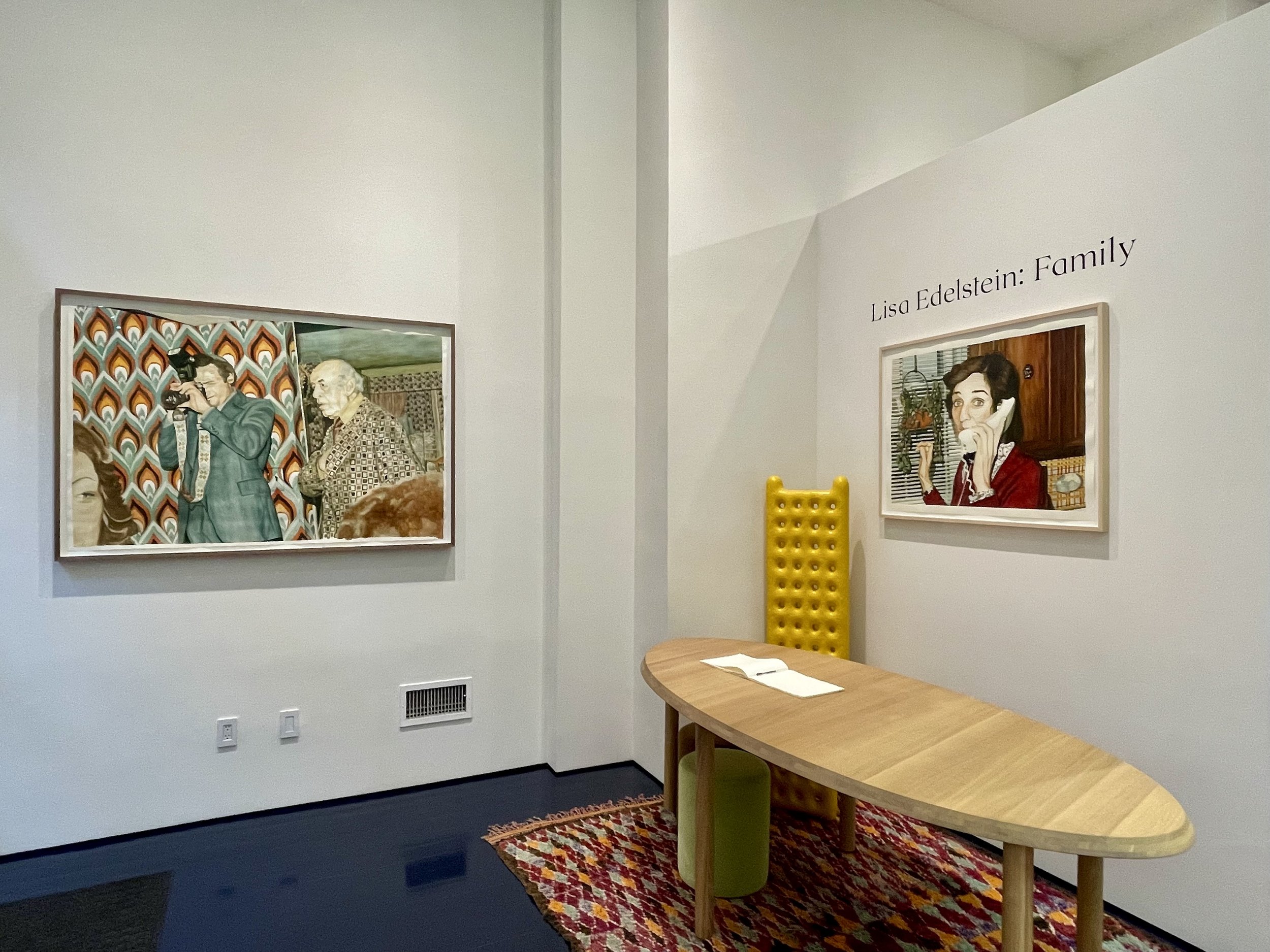REFRESHING THE NARRATIVE: An Interview with Lisa Edelstein
Lisa Edelstein, Interruption, 2022, Watercolor and pencil on paper, 28 by 38 inches, Courtesy of SFA Advisory
When someone tells you they created their own coloring book, a typical reaction might be to imagine a book of simple line drawings that can easily be filled in. You might also make a similar assumption about the kind of artwork someone who started painting during the pandemic lockdown would make. However, if these are your assumptions, upon meeting Lisa Edelstein, you will quickly realize that you have grossly underestimated her. Edelstein, known early on as Lisa E., is mostly recognized as an actor for her roles on “House,” “Girlfriends’ Guide to Divorce,” and “The Kominsky Method,” among others. After learning that her acting career began at Manhattan’s La MaMa Experimental Theater Club with the production of “Positive Me,” an AIDS awareness musical which she wrote, composed, and performed, I got the sense that when she starts something, she tends to “go big!” I asked her, “So what happens to you when you’re not actively working on something?” She laughed and said, “I need to be active. Maybe it's this underlying fear or anxiety of not working again, but I tend to hyperfocus on projects. I hate the feeling of wasting my time.” She says this lightheartedly, in the same way that she told me she started this body of work (which is now a solo exhibition at Lisa Schiff’s art advisory space in Tribeca) as a DIY coloring book project.
As I look around the walls of Schiff’s elegantly designed gallery space, I see sophisticated, large-scale ink and watercolor paintings that depict candid images of suburban family life from the 70s. Colors and textures, accessories and objects all provide subconscious (or conscious?) clues as to the stories behind each image. Two paintings “Celebration” and “Snapshot” depict men wearing yarmulkes, the only hint within the images that the family is Jewish, a detail that has inadvertently led to strong reactions from viewers and spurred the panel discussion entitled “Jewish Identity” held at the opening of Edelstein’s exhbition. When I asked her about it, she responded that she was just representing moments from her own life and didn’t realize that emblems of Judaism within her paintings would be such a focal point. “I’m for sure a Jewish artist and therefore Jewish content inevitably will be a part of my practice ‘cause it’s a part of me.” Nevertheless, Edelstein realized that she touched upon something novel in this work — Judaism is rarely represented in art history or contemporary art. If she is to be the artist who will provide this representation, she said she is ready to do it.
After the opening, I had the opportunity to interview Lisa and ask her a few more questions about her work and her process. The following is our conversation.
Lisa Edelstein, Celebration, 2021, Watercolor and pencil on paper, 30 by 40 inches, Courtesy of SFA Advisory
Lisa Edelstein, Snapshot, 2022, Watercolor and pencil on paper, 40 by 60 inches, Courtesy of SFA Advisory
SW: How did you learn to draw like that? You’re so talented. What was your process for starting the drawings?
LE: I used to draw a lot as a kid, all through high school. Once I left to go to college, I let it slide away from me. Occasionally I’d pick it up again but didn’t know what to draw and felt like I was just ruining good paper. But when I met my husband (artist Robert Russell), he really loved and appreciated what little drawing I was doing, and I started to feel like maybe they did have a place in the world. Little by little, I began to appreciate that part of myself and that version of expression from myself. So when the pandemic hit and lockdown happened, it all came to a head. Within two weeks I’d watched every pandemic movie, disaster movie, apocalypse movie, and zombie show ever made, all while putting together 1,000 piece jigsaw puzzles. It really wasn’t a good enough way to spend my time. I remembered my love for drawing but still wasn’t confident enough to know what to draw so I leaned into my old love for coloring and for markers. I got myself a coloring book and went to work. The problem was, I hated the images I’d spent hours and hours making. So I challenged myself to make my own coloring book using what was available to me: old family photos.
SW: Was there any Aha! moment you can pinpoint during the process as the moment when you decided you could keep going and you realized you had a serious body of work?
LE: We have a lot of artists and art world folk in our lives so whenever someone would come over to see Robert’s studio and the gorgeous paintings he’s working on he’d say “You should see what Lisa’s doing,” and send them over to my little studio office space. It was really exciting to see people react positively to what I was doing, especially when it was my husband pushing it forward. He is wildly supportive of whatever I do but this is his territory, and I have a lot of respect for him so it meant even more coming from him.
Lisa Edelstein, Robert , 2022, Watercolor and pencil on paper, 25 by 23 inches, Courtesy of SFA Advisory
Lisa Edelstein, Pizza, 2020, Marker and pencil on paper, 22 by 30 inches, Courtesy of SFA Advisory
SW: How did you choose which photographs to paint?
LE: I have spent a lot of time looking through my pile of old photos. In the beginning, when I was just using markers, I looked for images that had a lot of pattern for me to lean into. The fashion of the 60s and 70s was perfect for that. But later, as I moved into ink and then watercolor (and now oil), it opened up the world to me to just focus on what I discovered was most important to me: narrative. I scour the pictures for moments that feel real to me, not edited or posed. Or if they are posed, that there is something out of control happening within them, something that makes the people more vulnerable, more full of life and story. I’m looking for moments that people will recognize themselves in. I find that these kinds of images give people a lot of pleasure because they aren’t the kind of images we create today. We are too camera-savvy, we have too many filters, and our use of social media makes us aware of the forever quality a picture can have, so we greatly control how we portray our lives.
SW: How did it feel to sell your first painting?
LE: Terrifying! And hard to do because I didn’t want to let go of it. Also hard because it was a friend so the exchange felt weird. The first friend that bought a painting did it as an exchange for a donation to an animal charity because I didn’t know how to ask for money or how much to ask for. The second friend insisted on paying cold, hard cash. She wanted me to know it was worth it to her and that I should be paid for the hard work. It was very sweet of her! She took the pressure off. The third went to an actual collector who saw images of the paintings at an event and freaked out. Anyway, it was all very exciting, and it continues to be. It’s harder to let go of some than others but so far they’re all going to awesome places, and I’m happy they’ll be celebrated.
Lisa Edelstein, Dessert, 2022, Watercolor and pencil on paper 26 by 53 inches, Courtesy of SFA Advisory
Lisa Edelstein, Caught, 2022, Watercolor and pencil on paper 33 by 23 inches, Courtesy of SFA Advisory
SW: What was the most exciting part of creating each image?
LE: There’s a certain witchy feeling about painting a long-ago moment of a person who sometimes is long gone. They didn’t know, in the moment the photo was snapped, that I’d be doing such an intimate study of them way, way in the future. Or that when I did, I might even know how they died. It feels almost unfair, capturing people this way, but it’s also an act of love and in the case of this series, an appreciation of family. There are so many surprises when you break down an image to its tiniest pieces … a gesture, a cigarette, a blurry face in the background … objects appear that were passed over as pixels just moments before. It’s such an interesting journey.
Lisa Edelstein, Gun, 2022, Watercolor and pencil on paper 36 by 31 1/2 inches, Courtesy of SFA Advisory
SW: What are you currently exploring/working on? What kind of work can we expect to see from you going forward?
LE: Right now I’m learning how to paint in oils. I’m on my third try. The first one was a bit of a disaster so after I finished the second and third I went back to it. Unlike watercolor, an oil painting can be a disaster for awhile and then come together. With watercolor you kind of have one chance to get it right and then it’s a matter of accepting it. You can change some things but it’s not a layering process like oil. So I’m enjoying being messy right now. It’s all fun and games until you ruin your brand new sweater by walking past your pallete! That happened today. I’m covered in pinks. Oh well. Anyway, it’s a very different way of telling a story and I think it will call for different kinds of images yet again. But I have no idea just yet what direction its all going in. It’ll be fun finding out.
~
As a natural storyteller, Edelstein makes paintings that bring out questions and emotions regarding identity that only a new and fresh voice can uncover. There is no pretention, no judgement, just a sense of pure exploration. As her voice grows stronger, the challenge will be to maintain the genuine inquisitiveness that has led her in this direction in the first place. I look forward to attending her next show!
What are your thoughts? Please leave your comments below!
Installation at SFA Advisory, Lisa Edelstein: Family, Courtesy of SFA Advisory
Installation at SFA Advisory, Lisa Edelstein: Family, Courtesy of SFA Advisory
Installation at SFA Advisory, Lisa Edelstein: Family, Courtesy of SFA Advisory












